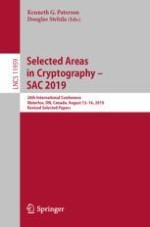2020 | OriginalPaper | Buchkapitel
On the Real-World Instantiability of Admissible Hash Functions and Efficient Verifiable Random Functions
verfasst von : Tibor Jager, David Niehues
Erschienen in: Selected Areas in Cryptography – SAC 2019
Aktivieren Sie unsere intelligente Suche, um passende Fachinhalte oder Patente zu finden.
Wählen Sie Textabschnitte aus um mit Künstlicher Intelligenz passenden Patente zu finden. powered by
Markieren Sie Textabschnitte, um KI-gestützt weitere passende Inhalte zu finden. powered by
